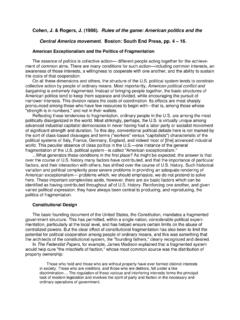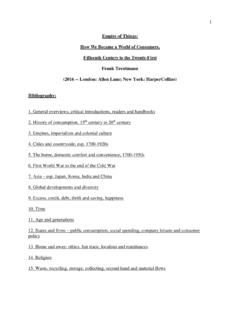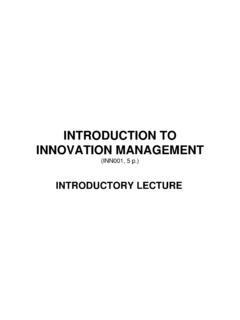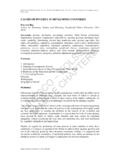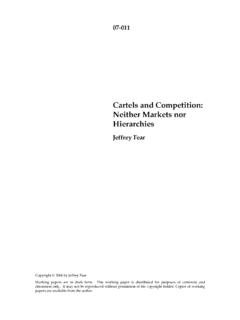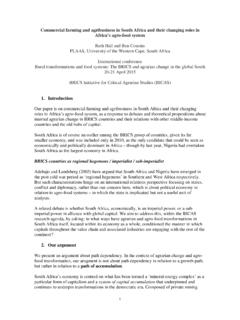Transcription of RALPH DAHRENDORF’S CONFLICT THEORY OF SOCIAL ...
1 Innovative Issues and Approaches in SOCIAL Sciences, Vol. 6, No. 3 | 117 RALPH dahrendorf S CONFLICT THEORY OF SOCIAL DIFFERENTIATION AND ELITE THEORY Jacek Tittenbrun1 Abstract dahrendorf s conception of SOCIAL differentiation poses some interesting theoretical problems inasmuch as it, owing to its putative associations with Marx s framework, is regarded as a class THEORY , but in fact displays also some salient characteristics of stratification approaches, while lacking some core characteristics of class THEORY . Upon scrutiny, however, it turns out that it is most closely related to the framework of elite THEORY .
2 This is revealed when dahrendorf s treatment of SOCIAL differentiation is compared with some approaches representative of the aforementioned THEORY . Keywords: CONFLICT THEORY , class, SOCIAL stratification, class THEORY , elite THEORY , Mosca, Pareto Introduction. RALPH dahrendorf arguably ranks amongst the most influential SOCIAL theorists of the former century. Given this significance, it is worth revisiting his CONFLICT THEORY from the angle of what kind of SOCIAL differentiation conception it adopts. SOCIAL differentiation is here meant as the most general term, of which SOCIAL stratification and class THEORY are principal subtypes.
3 This clarification is needed owing to the persistent conflation of SOCIAL differentiation with SOCIAL stratification in which usage it is the latter concept that is located at the top, SOCIAL class, for instance, being its variety or, worse still, part. Meanwhile, there is a world of difference between a stratum and a class. First and foremost, SOCIAL stratification is by definition a hierarchy ranking individuals or categories according to some criteria, such as income, prestige, etc. SOCIAL , or should we say, socio-economic classes are interrelated in a more complex fashion, irreducible to any ladder-like structure.
4 Furthermore, strata are universal both in space and in time, that is to say, they can be located throughout society, while classes are SOCIAL 1 Jacek Tittenbrun, Ordinary Professor, Chair of History of Sociology, Adam Mickiewicz University, Poznan Innovative Issues and Approaches in SOCIAL Sciences, Vol. 6, No. 3 | 118 groups rooted in the economy, and, secondly, the latter, as opposed to stratification, are born in a certain historical period and are not supposed to persist eternally. With those notions in mind, we can commence our analysis thanks to which it will be possible, as already demonstrated above, to raise a number of important theoretical and substantive issues.
5 dahrendorf as a critic of structural functionalism and Marxism. So let us assume as a tentative working hypothesis, to be verified, refuted, or modified in the course of our investigation, that dahrendorf s CONFLICT THEORY (1959) represents a mixed system having some properties of both alternative approaches. Darendorf s starting point is that neither structural functionalism nor Marxism alone provides an acceptable perspective on advanced society. He claims that structural functionalists neglect realities of SOCIAL CONFLICT and that Marx defined class too narrowly and in a historically-specific context.
6 Furthermore, he believes that traditional Marxism ignores consensus and integration in modern SOCIAL structures. There are a number of serious problems with those statements. Firstly, the said division of SOCIAL theories into integration and CONFLICT ones, or, in another wording, static and dynamics, equilibrium and change etc. fails to take account of the fundamental fact that each structural THEORY contains at least implicitly a THEORY of change and the reverse is also true there can be no THEORY of change which would not refer at least tacitly to a definite conception of structure.
7 If one defines a structure and identifies within it a set of core components, one by the same token points to the most likely source of a qualitative change of that structural whole. And, similarly, you cannot speak about change without assuming what is subject to that change. dahrendorf s characterisation is thus unfair, Parsons structural-functional THEORY of SOCIAL system, even ignoring, at the moment, his writings on evolution of societies, includes a better or worse THEORY of SOCIAL change. Likewise, Marx s THEORY of CONFLICT and development is inextricably interwoven with his detailed conception of the structure and functioning of a society undergoing given transformations.
8 Michio Morishima argues that Marx should [..] be ranked as high as Walras in the history of mathematical economics. It has rarely been pointed out that the general equilibrium THEORY was formulated independently and simultaneously by Walras and Marx (1978). Secondly, dahrendorf commits an error which is, to be sure, frequent, but this fact does by no means justify him - A bipolar conception of class is indeed over-simplified, but it is doubtful whether it could be attributed Innovative Issues and Approaches in SOCIAL Sciences, Vol. 6, No. 3 | 119 to Marx. The source of this misconception is obviously The Communist Manifesto, and its famous statement: Our epoch, the epoch of the bourgeoisie[.]
9 ] has simplified class antagonisms. Society as a whole is more and more splitting up into two great hostile camps, into two great classes directly facing each other bourgeoisie and proletariat . This claim, however, can be interpreted in different ways. Amongst others, it can be regarded as a prediction of the future development rather than as a statement of fact. Even in the same Marx and Engels work one can find sentences pointing to a more complex picture of societal differentiation. This view is also even more clearly present in Marx s historical works. In 18th Brumaire of Louis Bonaparte he writes, for example, about aristocracy of finance, the industrial bourgeoisie, the middle class, the petty bourgeoisie.
10 Thus, according to this account the bourgeois class should be further subdivided. And in his unfinished chapter on class in the 3rd volume of Capital Marx mentions at least one large class, that of landowners, and suggests that the class structure of capitalist society is in fact more complicated . The question of scientific fairness may be important, but what is crucial from the perspective of dahrendorf s own analytical framework is that he adopts the very approach he criticises and declaratively rejects. Be that as it may, dahrendorf combines elements from both of these perspectives to develop his own THEORY concerning class CONFLICT in post capitalist society.




